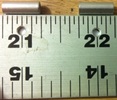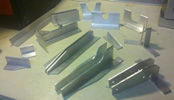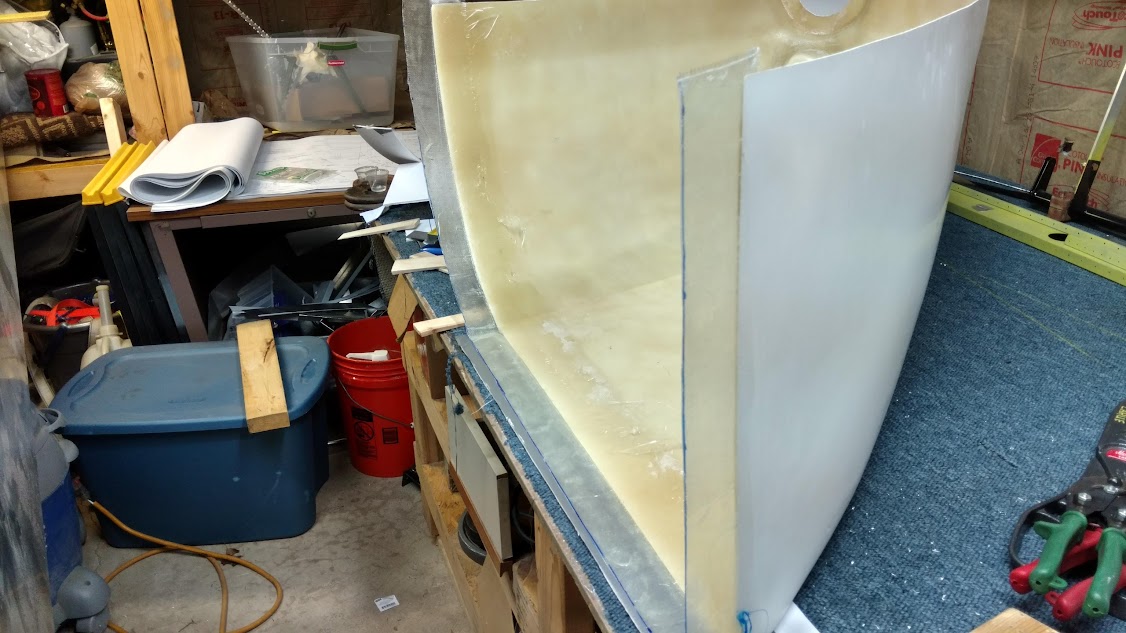


random user submitted photo
Cowling Modification
11 posts
• Page 1 of 2 • 1, 2
Cowling Modification
The gentleman I bought my Jabiru 3300 from purposely bought it with a 2" prop hub extension as used in planes such as the Zodiac 601. He told me that he thought the cowling could be extended forward to allow incoming air to flow into the engine better. I think the idea is that some of the air entering the right side of the cowling is ramming into the front cylinder, and spilling back out. The air that doesn't spill out still has to make a sharp bend to get over the front cylinder. That's the theory anyway.
I just started extending the rear edges of the cowling, but I'm awaiting some more fiberglass. In the meantime, I've been asking myself is it's worth the bother, or if it's a good idea. A friend of mine gave me the standard length hub in case I want to go that route, but I know if I have heating issues I'd wish I tried this.
I've heard from a few sources that the Jabiru 3300 is hard to keep cool in a Sonex cowling, so I feel compelled to try.
Any thoughts?

I just started extending the rear edges of the cowling, but I'm awaiting some more fiberglass. In the meantime, I've been asking myself is it's worth the bother, or if it's a good idea. A friend of mine gave me the standard length hub in case I want to go that route, but I know if I have heating issues I'd wish I tried this.
I've heard from a few sources that the Jabiru 3300 is hard to keep cool in a Sonex cowling, so I feel compelled to try.
Any thoughts?
Last edited by lpaaruule on Wed Dec 30, 2015 9:37 pm, edited 2 times in total.
Paul LaRue
Sonex N454EE Plans# 1509
Jabiru 3300
First Flight 12/21/2017
http://www.mykitlog.com/lpaaruule
Sonex N454EE Plans# 1509
Jabiru 3300
First Flight 12/21/2017
http://www.mykitlog.com/lpaaruule
-

lpaaruule - Posts: 233
- Joined: Wed Mar 26, 2014 6:33 pm
- Location: SE Michigan
Re: Cowling Modification
It is not hard to keep a Jab3300 cool in a stock Sonex cowl. You just need to open up the exit a bit more than the plans call for.
John Gillis
SEL Private, Comm Glider, Tow pilot (Pawnee Driver)
Waiex N116YX, Jabiru 3300, Tail dragger,
First flight, 3/16/2013. 403 hours and climbing.
Home: CO15. KOSH x 5
Flying a B-Model Conversion (Super Bee Baby!)
-

fastj22 - Posts: 1594
- Joined: Sun Aug 21, 2011 5:56 pm
- Location: Mile High
Re: Cowling Modification
I think a 2 " prop extension might actually be a good mod for cooling. It would give a little more room to enable the incoming air to be slowed. You will probably also avoid having to chop off those cooling fins on the front right head.
Steve
Sonex 892
Steve
Sonex 892
Steve
Lazair kit 1981 sold
Sonerai 2LS plansbuilt 2003 sold
Sonex kit 2010
Sonerai 2LS project rotax 912
Lazair kit 1981 sold
Sonerai 2LS plansbuilt 2003 sold
Sonex kit 2010
Sonerai 2LS project rotax 912
-

sonex892. - Posts: 414
- Joined: Tue Oct 27, 2015 12:32 am
Re: Cowling Modification
It would look better too .
Ben
Sonex # 1684
Tri-Gear, Dual Control
Rotax 912uls
N379BS reserved.
Sonex # 1684
Tri-Gear, Dual Control
Rotax 912uls
N379BS reserved.
- Concorde
- Posts: 176
- Joined: Sun Aug 10, 2014 2:11 pm
- Location: North Carolina
Re: Cowling Modification
I extended mine with a 5/8" thick spacer between hub and prop and made longer bushings. Did that mainly due to standard cowl was just too tight around Jabiru 3300. That 5/8" (16 mm) Greatly improves airflow around engine, especially back to oil cooler. Do need to carefully close off all leak paths so that ALL air that enters passes through fins to pick up heat. Doing that, have not needed to increase exit vents even with tapping off some air to cool mags, voltage regulator, and fuel pump. Secondary advantage of that type of prop spacer is precision made bushings are held square in reamed CNC bored holes in spacer and cannot wobble if bolts get a bit loose. I think Prince Propellers may sell a one piece spacer with integral bushings that may accomplish same.
One other factor to keep in mind is the effect of spiraling air from prop. with a Jabiru, or CAMit engine, it tends to throw air up and over cylinder #2, and down into #1. This effect is most noticeable in CHTs during climb at full power and low air speed. A dropped ceiling in left intake to keep air down and into #2 with similar clearance to what exists on cylinder #1 made all CHTs quite even. Rounding off leading top corner fins of #2 similar to what Sonex instructions call for on #1 also helps a bit. Final tweak was lowering ceiling of Sonex aluminum plenums by about 3/4" starting taper over cylinders #3 and 4. Simple plate baffles extending down from top might seem do same, but the resulting turbulence robs the air stream of momentum that creates the pressure differential across cylinder and head fins. With the Sonex or Jabiru supplied plenums, keeping the air moving with minimal turbulence is most effective. As an example of the effect of turbulence, for winter flying I place a couple of about 5/16" dia. (8 mm) round bars across to opening to cause a bit of turbulence and just that raises head temps sufficiently for winter. I also have a few small holes in ramps leading from intake to first cylinders to direct a small bit of air around underside of those cylinders that would otherwise be shielded in hopes of eliminating some potential hot spots. Note: For similar reasons, the gull wing baffles between cylinders should be on bottom as per Sonex instructions, not on top as per earlier Jabiru instructions.
David A.
One other factor to keep in mind is the effect of spiraling air from prop. with a Jabiru, or CAMit engine, it tends to throw air up and over cylinder #2, and down into #1. This effect is most noticeable in CHTs during climb at full power and low air speed. A dropped ceiling in left intake to keep air down and into #2 with similar clearance to what exists on cylinder #1 made all CHTs quite even. Rounding off leading top corner fins of #2 similar to what Sonex instructions call for on #1 also helps a bit. Final tweak was lowering ceiling of Sonex aluminum plenums by about 3/4" starting taper over cylinders #3 and 4. Simple plate baffles extending down from top might seem do same, but the resulting turbulence robs the air stream of momentum that creates the pressure differential across cylinder and head fins. With the Sonex or Jabiru supplied plenums, keeping the air moving with minimal turbulence is most effective. As an example of the effect of turbulence, for winter flying I place a couple of about 5/16" dia. (8 mm) round bars across to opening to cause a bit of turbulence and just that raises head temps sufficiently for winter. I also have a few small holes in ramps leading from intake to first cylinders to direct a small bit of air around underside of those cylinders that would otherwise be shielded in hopes of eliminating some potential hot spots. Note: For similar reasons, the gull wing baffles between cylinders should be on bottom as per Sonex instructions, not on top as per earlier Jabiru instructions.
David A.
- DCASonex
- Posts: 934
- Joined: Mon Sep 12, 2011 8:04 pm
- Location: Western NY USA
Re: Cowling Modification
Keep in mind the moving the entire cowling forward may change the geometry of the baffles. You may have to redo some or all of the baffle seals.
Ryan Roth
N197RR - Waiex #197 (Turbo Aerovee Taildragger)
Knoxville, TN (Hangar at KRKW)
My project blog: http://www.rynoth.com/wordpress/waiex/
Time-lapse video of my build: https://www.youtube.com/watch?v=Q8QTd2HoyAM
N197RR - Waiex #197 (Turbo Aerovee Taildragger)
Knoxville, TN (Hangar at KRKW)
My project blog: http://www.rynoth.com/wordpress/waiex/
Time-lapse video of my build: https://www.youtube.com/watch?v=Q8QTd2HoyAM
-

Rynoth - Posts: 1308
- Joined: Fri Jul 26, 2013 1:32 pm
- Location: Knoxville, TN
Re: Cowling Modification
I extended my cowling 50mm, used the prop hub extension mainly so I could use the Jabiru supplied plenum chambers but it also allowed me to put the oil cooler at the front of the engine. Another benefit is helping the CofG because of the light weight 2.2 Jab. Its a lot of extra work.
http://www.mykitlog.com/users/display_l ... 1458&row=8
http://www.mykitlog.com/users/display_l ... 1458&row=8
Phil Bird
Sonex 759 JAB 2.2 Tailwheel
Mittagong NSW Australia
http://www.mykitlog.com/corby202/
https://www.flickr.com/photos/78427482@ ... otostream/
Sonex 759 JAB 2.2 Tailwheel
Mittagong NSW Australia
http://www.mykitlog.com/corby202/
https://www.flickr.com/photos/78427482@ ... otostream/
- Corby202
- Posts: 223
- Joined: Mon Dec 30, 2013 2:08 am
Re: Cowling Modification
Thanks everyone for the comments so far. I think everyone had some good points.
Phil, your cowling looks good. It appears that you had to cut horizontal slices out on the top sides to keep the cowling from rising too high? You made a good point about the CofG moving forward. That works out for the 2200, but my concern would be the opposite for my 3300.
John, making the exit holes larger than the plans call for sounds like it has worked for some people. However, I remember Jeremy talking about a builder that apparently made them too large, and ended up getting ram air into the bottom of the cowling. His engine was destroyed due to lack of airflow.
I will say that watching the video yesterday of Jim Hicke and his wife take off from Las Vegas on a 105 degree day makes me think that this modification isn't worth the effort. I may send him a PM to see if he's done anything special for cooling.
I still have a few days before the fiberglass gets here, enough time to change my mind a few more times! :D
Phil, your cowling looks good. It appears that you had to cut horizontal slices out on the top sides to keep the cowling from rising too high? You made a good point about the CofG moving forward. That works out for the 2200, but my concern would be the opposite for my 3300.
John, making the exit holes larger than the plans call for sounds like it has worked for some people. However, I remember Jeremy talking about a builder that apparently made them too large, and ended up getting ram air into the bottom of the cowling. His engine was destroyed due to lack of airflow.
I will say that watching the video yesterday of Jim Hicke and his wife take off from Las Vegas on a 105 degree day makes me think that this modification isn't worth the effort. I may send him a PM to see if he's done anything special for cooling.
I still have a few days before the fiberglass gets here, enough time to change my mind a few more times! :D
Paul LaRue
Sonex N454EE Plans# 1509
Jabiru 3300
First Flight 12/21/2017
http://www.mykitlog.com/lpaaruule
Sonex N454EE Plans# 1509
Jabiru 3300
First Flight 12/21/2017
http://www.mykitlog.com/lpaaruule
-

lpaaruule - Posts: 233
- Joined: Wed Mar 26, 2014 6:33 pm
- Location: SE Michigan
Re: Cowling Modification
lpaaruule wrote:Phil, your cowling looks good. It appears that you had to cut horizontal slices out on the top sides to keep the cowling from rising too high? You made a good point about the CofG moving forward. That works out for the 2200, but my concern would be the opposite for my 3300.:D
You can easily offset the change of C of G by a couple of means. Not use the heavy 3lb billet spinner and use a fibreglass spinner. For example, my spinner, including crush plate and mounting discs is 1/3rd the weight of the billet spinner. A lithium battery could also help. My battery weighs 15.4 lbs the replacement lithium ion only 3.7 lbs
Steve
Sonex 892
3300
VH-ZSX
Steve
Lazair kit 1981 sold
Sonerai 2LS plansbuilt 2003 sold
Sonex kit 2010
Sonerai 2LS project rotax 912
Lazair kit 1981 sold
Sonerai 2LS plansbuilt 2003 sold
Sonex kit 2010
Sonerai 2LS project rotax 912
-

sonex892. - Posts: 414
- Joined: Tue Oct 27, 2015 12:32 am
Re: Cowling Modification
There is a limit to how much you can make the exit. If you extend past where the lip creates a low pressure, you will pressurize the cowl from the bottom. When I had the stock cowl (I've since fabricated the Corvair cowl to replace it, just like the looks), I ended up just eliminating the dual exits and creating a single exit plate. I used piano hinge on either side so I could fine tune the size of the plate. That solved any heat issues I had. Added benefit was I could easily remove the plate to access the carb and bottom of the engine without de-cowling.
John Gillis
SEL Private, Comm Glider, Tow pilot (Pawnee Driver)
Waiex N116YX, Jabiru 3300, Tail dragger,
First flight, 3/16/2013. 403 hours and climbing.
Home: CO15. KOSH x 5
Flying a B-Model Conversion (Super Bee Baby!)
-

fastj22 - Posts: 1594
- Joined: Sun Aug 21, 2011 5:56 pm
- Location: Mile High
11 posts
• Page 1 of 2 • 1, 2
Who is online
Users browsing this forum: No registered users and 7 guests







